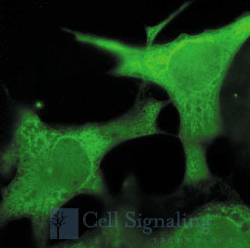This web page was produced as an assignment for Genetics 677, an undergraduate course at UW-Madison.
Future Directions
To further investigate the role of MYC in Burkitt Lymphoma there are many routes that can be taken since there is not a whole lot of knowledge regarding this disease and gene interaction. One of the first things that should be done is try to uncover the cause of the translocation of the MYC allele into the locus encoding for the constitutively expressed immunoglobulin chains. Gaining knowledge of the underlying mechanism in which this mutation occurs could possibly aid in the prognosis and prevention of this life threatening disease. Another area to look into is if gene therapy with MM-1 or Smad3 would prove useful in the prevention of tumorigenisis. Techniques along these lines could possibly include expression of these proteins in tumors to control the proliferation and cell growth that is experienced. MM-1, for example, could possibly be targeted towards the MYC translocation in the immunoglobulin locus and disrupt the constitutive expression of MYC. As displayed on the Protein Network and Pathways page there are a wide variety of interactions that MYC is involved with. To detect the specific interactions of down-regulation and up-regulation, microarrays of Burkitt patients versus normal individuals could be of significant advantage. The Phenotypes and Gene Ontology page contains an interaction with the MYC homolog diminutive contained in drosophila with dMnt. It is shown here that a dm/dMnt mutant was larger in size compared to the single null mutation of dm. Due to this larger size, it may be likely that there are other proteins that contain the basic helix-loop-helix domain (indicative of a transcription factor) that may be rescuing the phenotypes of these larvae. Using techniques such as TAP (Tandem Affinity Purification) tagging and Mass Spectrometry (MS), the presence of "rescue" proteins maybe be found. Another area to look into to better understanding the relationship of the gene and the disease may lie in comparing the cell cycle in different stages in cells affected with Burkitt Lymphoma and compare them to what is know with cells that display the normal progression through the cell cylce. Last of all, while a lot of the scientific literature that was found dealt with the mouse and fly as model organisms, why not use the rat as a model for insight into the MYC protein and its relationship it holds with Burkitt Lymphoma. The rat protein was shy of the human protein by one amino acid, but the entire N-terminus domain was continuous where as the mouse and the fly had some discontinuations within the sequence.
Miscellaneous
MYC Tags
MYC has been used as an epitope to tag other proteins that do not have a specific antibody for identification in laboratory techniques such as immunoblotting, immunostaining, and immunoprecipation. (1) Not only is a MYC tag useful in protein detection and identification, it can be used to localize proteins to the nucleus where MYC performs its many functions as stated from its gene ontology.
Also, due to the small size of MYC it can be fused with other protein products without having to worry about interferring with the protein of interest's normal biochemical functions. (1)
To use the MYC tag, recombinant proteins are created and then reacted with an anti-MYC antibody often in accordance with a flourescent for ease in detection. Below is an image of a protein that has been tagged with MYC. (1)
Also, due to the small size of MYC it can be fused with other protein products without having to worry about interferring with the protein of interest's normal biochemical functions. (1)
To use the MYC tag, recombinant proteins are created and then reacted with an anti-MYC antibody often in accordance with a flourescent for ease in detection. Below is an image of a protein that has been tagged with MYC. (1)
The Hype over Genomes
As this class and semester project focused on genes and diseases, I found this recent article in the New York Times to be particularly interesting and relevant.
Genes Show Limited Value in Predicting Diseases
Genes Show Limited Value in Predicting Diseases
References
1http://www.cellsignal.com/products/2276.html
2Wade, Nicholas (2009, April 16).Genes Show Limited Value in Predicting Diseases The New York Times. Retrieved from http://www.nytimes.com/
2Wade, Nicholas (2009, April 16).Genes Show Limited Value in Predicting Diseases The New York Times. Retrieved from http://www.nytimes.com/
Contact Info: Deeter Neumann, [email protected], May 14, 2009

